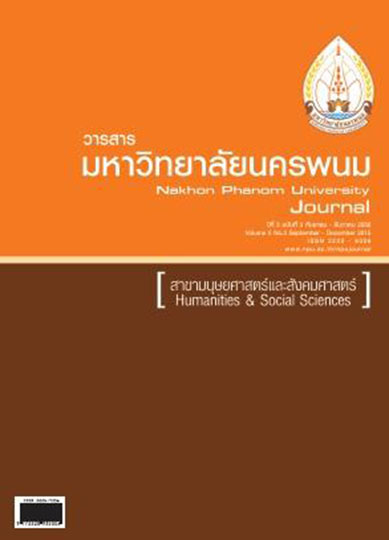สมรรถนะประจำสายงานของครู ในโรงเรียนพระปริยัติธรรมแผนกสามัญศึกษา จังหวัดนครพนม
Main Article Content
Abstract
การวิจัยในครั้งนี้มีจุดประสงค์เพื่อ 1) ศึกษาสมรรถนะประจำสายงานของครู ในโรงเรียนพระปริยัติธรรม แผนกสามัญศึกษาจังหวัดนครพนม 2) เพื่อเปรียบเทียบความคิดเห็นต่อสมรรถนะประจำสายงานของครู จำแนกตามสถานภาพ และขนาดของโรงเรียนกลุ่มตัวอย่างมี 138 รูป / คน จำแนกเป็น ผู้บริหาร จำนวน 43 รูป และ ครูผู้สอน จำนวน 95 รูป / คน กำหนดขนาดกลุ่มตัวอย่างโดยใช้เกณฑ์ร้อยละ 80 ของประชากรผู้บริหารและครูผู้สอน และใช้การสุ่มแบบแบ่งชั้น เครื่องมือที่ใช้เป็นแบบสอบถามมาตราส่วนประมาณค่า 5 ระดับ(Rating Scale) ค่าอนาจจำแนกรายข้อระหว่าง 0.42 - 0.86 ค่าความเชื่อมั่นทั้งฉบับเท่ากับ 0.98 สถิติที่ใช้ในการวิเคราะห์ข้อมูล ได้แก่ ร้อยละ ค่าเฉลี่ย ส่วนเบี่ยงเบนมาตรฐาน ทดสอบสมมติฐานโดยใช้ t-test และ F-test (One-way ANOVA) ผลการวิจัย พบว่า 1) ครูมีสมรรถนะประจำสายงาน โดยรวมและรายด้านอยู่ในระดับมากทุกด้าน (x = 4.29, S.D = 0.30) ด้านที่มีค่าเฉลี่ยสูงที่สุด ได้แก่ ด้านการบริหารหลักสูตรและการจัดการเรียนรู้ (x = 4.38, S.D = 0.39) และด้านที่มีค่าเฉลี่ยตํ่าสุด ได้แก่ ด้านการบริหารจัดการชั้นเรียน (x = 4.22, S.D = 0.40) 2) ผู้บริหารและครูเห็นว่าครูมีสมรรถนะประจำสายงาน โดยรวมและรายด้านไม่แตกต่างกัน และผู้บริหารและครูในโรงเรียนขนาดต่างกัน มีความคิดเห็นโดยรวมไม่แตกต่างกัน เมื่อพิจารณาเป็นรายด้าน พบว่า แตกต่างกันอย่างมีนัยสำคัญทางสถิติที่ระดับ .05 จำนวน 1 ด้าน ได้แก่ ด้านภาวะผู้นำของครู (x = 4.31 , S.D = 0.40) โดยผู้บริหารและครูในโรงเรียนขนาดเล็กมีความคิดเห็น เห็นว่า ครูมีสมรรถนะตามสายงานสูงกว่า ผู้บริหารและครูในโรงเรียนขนาดใหญ่ และโรงเรียนขนาดกลาง
The purposes of this study were: 1) to investigate teachers’ functional competency in Phrapariyattidham Schools, General Education Department, Nakhon Phanom province, 2) to compare teachers’ functional competency as classified by respondents’ status and school size. The sample was 138 people consisting of 43 administrators and 95 teachers. The size of sample was determined using the criterion of 80 percent administrator and teacher population and the sample was selected by stratified random sampling. The instrument used in this study was a 5-rating scale questionnaire with the discrimination power values ranging between 0.42 and 0.86 and the reliability coefficient of 0.98. The statistics employed in data analysis were percentage, mean, standard deviation, t-test (independent samples) and F-test (One-way ANOVA).
The results were as follows. 1) The overall teachers’ functional competency was at high level (x = 4.29,S.D = 0.30) and its each aspect was at high level too. The aspect that gained the highest mean score was of curriculum and learning management (x = 4.38, S.D = 0.39), whereas the aspect that gained the lowest mean score was of classroom management (x = 4.22 , S.D = 0.40). 2) Administrators and teachers had no difference in their opinion on teachers’ functional competency as a whole and each aspect. Administrators and teachers in a differentsized school had no different opinion on teachers’ functional competency as a whole. Considering it by aspect, one aspect was found significantly different at the .05 level. That aspect was of teachers’ leadership (x = 4.31,S.D = 0.40). Administrators and teachers in a small-sized school had their significantly higher opinion on teachers’ functional competency than those in a large or medium sized school.


